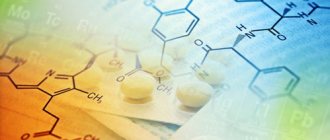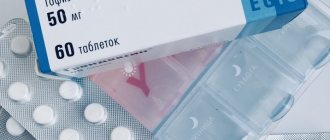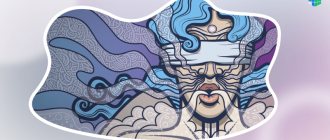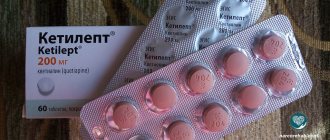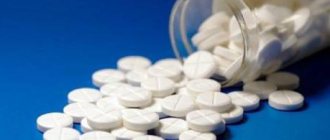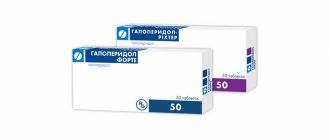To reduce the risk to the patient's health during the use of this group of psychotropic drugs, a new generation of antipsychotics or atypical antipsychotics, which have a milder effect on the human body, have been developed.
What are neuroleptics
Neuroleptics are psychotropic drugs, the main function of which is to relieve a psychotic disorder, in particular, its productive symptoms. These include delusions, hallucinations, pseudohallucinations, mania, anxiety, aggressiveness, behavioral and thinking disorders.
That is why antipsychotics are prescribed for psychosis and other disorders with behavioral disorders, excitability and aggressiveness:
- schizophrenia;
- bipolar disorder;
- mania;
- phobias;
- affects;
- hysteria;
- severe forms of insomnia;
- senile dementia;
- autism;
- obsessive-compulsive neurosis.
The mechanism of action of antipsychotics is based on blocking D2 receptors of the neurotransmitter dopamine, as well as reducing its transmission in various brain systems.
Antipsychotic, that is, the main effect of these drugs is associated with inhibition of dopamine transmission in the mesolimbic pathway. Thanks to this, positive symptoms are eliminated. But the effect is achieved only with blockade of 65% of the neurotransmitter.
Other effects include:
- hypnotic;
- sedative;
- anti-anxiety;
- antiemetic;
- hypothermic;
- hypotensive;
- stabilizes behavior.
The world first learned about antipsychotics in 1950 with the synthesis of aminazine. Previously, henbane, opiates, bromides, and antihistamines were used to treat psychosis.
Indications for use
Doctors prescribe antipsychotics for a range of mental disorders. The peculiarities of the effect of these drugs on the body allow them to be widely used in medical practice. Indications for treatment are:
- neurosis
- psychomotor agitation
- acute and chronic psychosis, including alcoholic
- withdrawal and delirium
- insomnia
- uncontrollable vomiting
- psychosomatic disorders
- Tourette's syndrome
- schizophrenia and schizoaffective disorders
- constant pain that is not relieved by other drugs, including those of unknown origin
- phobias
- intellectual-mnestic, bipolar and anxiety disorders
- hyperkinesis
- tremor
- neuralgia
- Parkinson's disease
- mental retardation
- senile dementia
- cerebral paralysis
- hallucinations
Side effects
All the negativity associated with typical antipsychotics and the need to eliminate atypical drugs in this group is caused by their adverse reactions.
By inactivating dopamine transmission in the mesolimbic pathways, they, at the same time, act similarly in the mesocortical, nigrostriatal and tuberoinfundibular pathways.
Being active in the nigrostriatal pathway, neuroleptics cause such complications as neuroleptic extrapyramidal disorders - the most typical for this group of drugs. They manifest themselves as parkinsonism with impaired motor activity in the form of slow movements, muscle stiffness, tremor, and drooling.
Another manifestation is acute dystonia, accompanied by involuntary spastic movements, as well as akathisia - the desire for constant movement to reduce internal discomfort and anxiety.
Neuroleptic extrapyramidal disorders can manifest themselves both at the beginning of antipsychotic therapy and at a later period. They are quite painful for the patient, complicate his life and aggravate the manifestations of the underlying disease.
Blocking dopamine in the mesocortical pathway leads to the development of neuroleptic depression, that is, negative symptoms appear. Among them are depressed mood, decreased physical activity, a feeling of hopelessness, etc. This condition increases the possibility of suicide. Against the background of the action of neuroleptics, cognitive functions also decrease, attention deteriorates, and memory decreases.
Another common complication of antipsychotic drug therapy is hyperprolactinemia (increased prolactin in the blood). It develops against the background of changes in the level of dopamine in the tuberoinfundibular pathway.
The disorder is accompanied by a decrease in the level of sex hormones. This entails changes in the human sexual sphere, for example, frigidity, anorgasmia, and impaired ejaculation. Affects sexual development, causes menstrual irregularities, changes in secondary sexual characteristics. Changes the psycho-emotional background: a person becomes irritable, anxiety and sleep disorders increase.
Other side effects from antipsychotics include anticholinergic disorders (constipation, dry mouth, drowsiness, confusion, changes in heart rate). They have a toxic effect on the liver and change the functioning of the heart, even leading to sudden death.
It should be noted that representatives of this group of drugs do not have the same effect on the human body. Depending on their type, they exhibit side effects to a greater or lesser extent.
Use in combination with neuroblockers
Advertising:
There are various indications for taking medications in combination with neuroblockers. This treatment helps with attention deficit disorder accompanied by hyperactivity. This disease is characterized by symptoms such as excessive impulsiveness and absent-mindedness.
Medications help relieve post-traumatic stress disorder.
Complex medication use is also indicated for anorexia and bulimia. They are also prescribed for generalized anxiety disorder, accompanied by depression and unreasonable fears. The main manifestation of this pathology is persistent anxiety, not associated with any stressful situations.
During pregnancy, many women experience a deficiency of progesterone in the body, which puts them at risk of miscarriage. In such cases, Utrozhestan is prescribed in the form of vaginal suppositories. Read more in the article: “after morning blood became liquid.”
Atypical antipsychotics: what are the advantages?
New generation neuroleptics were synthesized in order to reduce the occurrence of side effects and the development of complications during the use of this group of drugs.
Their action is similar to typical representatives, but has fundamental differences. Atypical antipsychotics selectively act on D2 receptors, that is, dopamine. First of all, drugs in this group affect those located in the mesolimbic pathway, and thus suppress the positive symptoms of psychosis.
Some representatives of this class of drugs exhibit a total antipsychotic effect, that is, they stop all productive symptoms, while others act selectively, stopping individual manifestations. These drugs do not affect receptors located, for example, in the nigrostriatal pathway, which significantly reduces the risk of extrapyramidal disorders. This is a fairly significant advantage of atypical antipsychotics. This property made it possible to radically change the attitude towards them. After all, it was previously believed that the antipsychotic effect of neuroleptics is impossible without the manifestation of extrapyramidal disorders. Conclusions about the therapeutic effect of the drug were based on their severity.
The new antipsychotics are called atypical because they do not exhibit the typical side effects of these drugs.
Clozapine, developed back in 1968, is considered the first neuroleptic of the new generation. Its extrapyramidal complications were minimal, but nevertheless its production had to be canceled. This was due to the fact that it caused a severe blood disorder. But subsequently clozapine was reinstated due to its unique functions, and therapy with it required constant monitoring of blood counts.
Since the 1980s, other new generation drugs began to appear.
Due to the selective effect of atypical neuroleptics on dopamine receptors, the degree of manifestation of neuroleptic depression and hyperprolactinemia during treatment with them is reduced. Moreover, they are even prescribed to relieve depression. Although such information is ambiguous. For example, it was found that some drugs from this group are capable, on the contrary, of causing motor neurological complications to an even greater extent. These include Olanzapine, Zeldox. And Risperidone, affecting the hypothalamus, causes hyperprolactinemia.
Atypical antipsychotics have a lesser effect on dopamine receptors. And mostly on serotonin. This allows you to influence the negative symptoms of mental illness, such as emotional coldness, anhedonia, and withdrawal.
In addition to the above properties, new antipsychotics enhance and enhance cognitive function.
Risperidone, Amisulpride, Iloperidone, Clozapine, etc. are considered classic representatives of 2nd generation antipsychotics.
Atypical psychotics are divided into 2 groups:
- The first of them includes drugs that equally block dopamine and serotonin receptors, and also selectively act on norepinephrine synapses - Risperidone, Sertindole. Drugs in this group have pronounced antipsychotic and antidepressant effects;
- Group 2 includes drugs that block serotonin receptors, as well as other mediators - Olanzapine. Their main effect is antipsychotic. Possible risk of hypotension.
Olanzapine and Eglonil
Olanzapine helps reduce neuronal activity. The drug improves psychomotor reactions. Olanzapine is effective in cases of exposure to frequent stress. The drug eliminates manifestations of phobias and depression.
Olanzapine helps with causeless aggression and obsessions.
Eglonil is a new generation drug with pronounced antipsychotic properties. The medication helps improve your mood. It is effective for depressive syndrome. Eglonil reduces the risk of psychomotor dysfunction. It can be used either alone or in combination with other medications. Eglonil is used in the presence of behavioral disorders, neuroses, causeless anxiety, and schizophrenia.
Negative properties
Despite the undeniable advantages of these drugs over classical ones, they nevertheless have several negative effects on the body.
First of all, this is the risk of weight gain, which can lead to obesity. The consequences include diabetes mellitus, heart disease, pancreatitis, and atherosclerosis. Atypical drugs are more likely to cause obesity than typical drugs.
Pathological absorption of fluid appears. A person can drink about 20 liters of water per day. It causes headaches, visual disturbances, digestive disorders and even coma.
All antipsychotics exhibit cardiotoxicity to varying degrees. These include rhythm disturbances, myocardial conduction, hypotension, and inflammation of the heart muscle. In severe cases in patients with cardiac pathology, antipsychotics cause myocardial infarction, angina pectoris, and cause sudden death.
Other side effects of atypical antipsychotics include drowsiness and sedation. At the beginning of therapy, such manifestations are even useful, especially in cases where the patient is overcome by insomnia. However, subsequently they lead to disruption of thinking, consciousness, motor activity, and interfere with daily work and professional activities.
Such effects, when they go beyond what is permitted, are often mistaken for new symptoms of the disease. This introduces certain difficulties in clearly understanding the picture of the disorder.
It is worth repeating that the effects of different representatives of atypical psychotics differ from each other. Among them there are drugs with minimal side effects. On the other hand, there are drugs whose effects are more pronounced, but also have more negative consequences.
Misrepresentation in antipsychotic drug studies
Many foreign review studies comparing antipsychotic drugs of different groups indicate the possibility of distortion of information in favor of more modern drugs.
Thus, S. Ahmer et al. [2] analyzed the dependence of the results of some studies on the effectiveness of antipsychotics depending on the sources of funding. It was shown that in studies funded by pharmaceutical companies, results were significantly more likely to be in favor of the newly created drug.
Some representatives of the group
Risperidone is probably the most prominent representative of the 2nd generation antipsychotics. Being a powerful dopamine receptor blocker, it exhibits a strong, effective antipsychotic effect. But, along with this, the list of its side effects is quite wide. Compared to other “atypists,” it causes depression, increased prolactin and extrapyramidal disorders to a greater extent, provokes nausea and vomiting, weight gain, drowsiness and other undesirable reactions. But no one writes him off, since he most effectively fights psychotic agitation.
Quetiapine . One of the safest atypical antipsychotics. Shows a pronounced anti-anxiety effect and normalizes mood. It has a weak effect on serotonin and dopamine receptors, and has a greater effect on adrenergic receptors. Used for schizophrenia and bipolar disorder.
Fluphenazine . The drug is for injection use. It has a moderate effect on the noradrenergic system, and a pronounced effect on the dopamine system. Eliminates irritability and has a psychoactivating effect. Used for hallucinations and to treat neuroses.
The drug is administered intramuscularly in a dose of 0.25 or 0.5 ml with further consideration of the administration regimen. It can enhance the effects of other psychotropic drugs and alcohol, so their simultaneous use is undesirable. When used in parallel with narcotic analgesics, it causes depression of the central nervous system and respiration.
Clopixol was developed more than 20 years ago. It is actively used abroad, but in Russia it was introduced into practice relatively recently. The drug acts on 3 types of receptors: serotonin, dopamine and adrenergic. Available in two forms: injections and tablets.
Injectable forms are Acufase and Depo.
Clopixol-Acupaz is used for acute psychosis, exacerbations of its chronic forms, as well as for mania. It eliminates the nuclear symptoms of schizophrenia: hallucinations, mania, disturbances in mental activity, relieves anxiety, aggressiveness, and reduces manifestations of hostility.
One injection of the drug is enough to relieve acute symptoms. The effect lasts up to three days. After this, they will probably appear again, so it is advisable to prescribe Clopixol in the form of depot or tablets.
Clopixol-Depot provides a prolonged sedative effect. The maximum effect is achieved after the first week after administration of the drug. A single injection of 1 ml of Clopixol-Depot for two weeks or 2 ml for four weeks replaces the daily intake of tablets of the same name for 14 days.
Negative symptoms
The effect of atypical antipsychotic drugs on the severity of negative symptoms also deserves attention. One of the first studies to evaluate the effectiveness of clozapine showed that its use reduced the severity of such symptoms [37]. This could not but attract attention, since it was believed that typical antipsychotic drugs do not affect negative symptoms.
Leucht S., Barnes TRE, Kissling W. et al. Relapse prevention in schizophrenia with new-generation antipsychotics: a systematic review and exploratory meta-analysis of randomized, controlled trials. Am J Psychiat 2003 S. Leucht et al. [48], who studied other drugs, found that haloperidol was more effective than placebo in terms of the severity of negative symptoms, and risperidone and olanzapine were more effective than haloperidol; quetiapine was no different from haloperidol. However, unfortunately, this study did not differentiate between primary (associated with the schizophrenic process itself) and secondary (due to the effects of neuroleptic drugs) negative symptoms.
Therefore, the results of a study of the effect of olanzapine and clozapine on primary negative symptoms were so significant [41, 62]: no such effect was found.
Some studies have been carried out on the effects of antipsychotic drugs on cognitive functions. It was already known that classical antipsychotics have little effect on these functions. It was assumed that atypical antipsychotic drugs would be more effective in this regard.
P. Harvey and R. Keefe [33] analyzed studies devoted to this problem with a preliminary assessment of their methodology. Of the 20 they analyzed, only five were randomized, double-blind, and of these, only two lasted longer than 9 weeks and only one lasted longer than 26 weeks.
Only half of the studies reported the dosage of drugs used, and when doses were reported, they were too high , ranging from 736 to 924 mg of chlorpromazine (equivalent to 14 to 18 mg of haloperidol).
In this regard, special attention has been paid to drug dosages. Thus, in a two-year double-blind study by M. Green et al. [30] compared the effects of low (5 mg) daily doses of haloperidol and risperidone.
The authors did not find significant differences in indicators reflecting the functional state of verbal memory. But R. Keete et al. [39] in a double-blind, randomized study lasting 104 weeks showed that therapy with olanzapine (average dose 11.3 mg/day) and haloperidol (average dose 4.87 mg/day) has a positive effect on neurocognitive indicators, with significant differences between these drugs was not found.
Thus, there is not yet sufficiently convincing data on the effect of atypical antipsychotics on primary negative symptoms and neurocognitive impairment.
Their advantages over typical antipsychotics in affecting positive symptoms are also still variable within the group, that is, there are significant differences in the action of individual antipsychotics. Therefore, it is necessary to further accumulate observations and conduct research taking into account the need to eliminate the methodological errors noted above.
Dosage regimens
The prescription of atypical antipsychotics must be strictly justified, and their administration requires strict adherence to the regimen. They are prescribed in several ways.
The most reliable and proven is a gradual increase in dose .
In contrast to the previous method, the fast : the dose is increased to an acceptable one within a few days, and all subsequent treatment is maintained at this level.
The zigzag method involves periodically changing high and low doses throughout the entire therapy.
The shock method involves administering the drug in the maximum dosage several times a week. Thus, the body experiences a kind of chemical shock, and psychosis recedes under its influence.
Combination therapy is also used , in which several groups of antipsychotics are used. These can be exclusively atypical antipsychotics or a combination of both generations.
List of used literature
1. Jones P.B., Buckley P.F. "Schizophrenia. Clinical guidelines".
2. Smulevich A.B. "Treatment of low-grade schizophrenia."
3. Snedkov E.V. "Atypical antipsychotics: searching for solutions to old and new problems."
4. Krasnov V.N., Gurovich I.Ya., Mosolov S.N., Shmukler A.B. "Standards of care for patients with schizophrenia."
5. Ivanov S.V., Smulevich A.B., Voronova E.I. “New generation antipsychotic cariprazine in the treatment of schizophrenia: spectrum of clinical efficacy and safety.”
6. Geddes J., Freemantle N., Harrison P., Bebbington P. “Atypical antipsychotics in the treatment of schizophrenia: systematic overview and meta-regression analysis.”
7. Jindal RD, Keshavan MS “Classifying antipsychotic agents. Need for new terminology."
8. Correll CU, Rubio JM, Inczedy-Farkas G. “Efficacy of 42 pharmacologic cotreatment strategies added to antipsychotic monotherapy in schizophrenia.”
9. Wang S.M., Han C., Lee S.J. “Investigational dopamine antagonists for the treatment of schizophrenia.”
10. K.S. Raevsky. "Modern neuroleptics: interaction with brain neurotransmitter systems."
Share
Share
Disorders of the cardiovascular and autonomic systems
On the part of the heart, taking antipsychotics often causes problems. This occurs most often in patients who are forced to use drugs for a long time. They note:
- increased heart rate
- rhythm disturbance
- slowing of intraventricular and atrioventricular conduction
Various changes may occur in the autonomic nervous system. They are usually observed after the use of neuroleptics with strong antipsychotic effects. But sometimes they arise as a result of long-term use of weaker drugs. Deviations appear as follows:
- sharp drop in pressure
- orthostatic collapse
- hyperhidrosis
Impact on the psyche
The use of antipsychotic drugs provokes the manifestation of mental and motor restlessness (akathisia). A person in this state cannot sit in one place, as at rest he develops anxiety and severe discomfort. Akathisia manifests itself both at the initial stage of treatment and as a result of long-term use of drugs. It is typical for all types of neuroleptics. The early form of anxiety is well controlled by correction of therapy, but the late form often takes a chronic course. It may first appear at the time of dose reduction or after complete discontinuation of the drug.
The patient’s nervous system sometimes reacts to the use of a neuroleptic with headache, dizziness, and sleep disturbances. Some people develop fear, depression or a state of euphoria, epileptic seizures. Cases of exacerbation of psychosis and hallucinations have been described.
